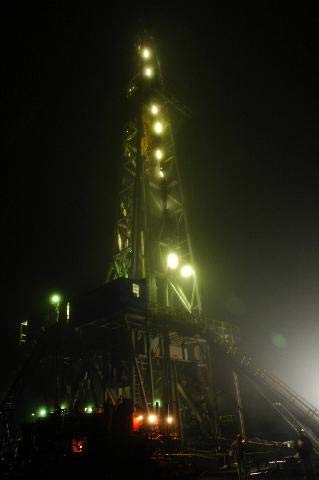Inside an Earthquake: 2 Miles Down in Fault Zone

Scientists breached a major underground earthquake zone this week in Southern California by drilling a hole more than 2 miles down into the San Andreas Fault.
The hole will be lined with steel and concrete, then instruments will be installed to monitor the many small and large temblors that occur on the fault.
Geologists at the drill site near Parkfield, Calif., the self-proclaimed earthquake capital of the world, reported Tuesday that the drill rig had reached the depth where local earthquakes originate.
"Our first indication of entering the fault zone was a modest increase in drilling rate starting at about 2:30," according to the project's online daily log. The shift marked entry into a less rigid area of rock.
Sensors also picked up increases in radon, hydrogen, carbon dioxide, all signs that the fault zone had been penetrated.
The drill was at 12,452 feet, or 2.3 miles (3.8 kilometers) down.
"We now have the first opportunity to measure directly the conditions under which earthquakes begin and grow," said Herman Zimmerman, director of the National Science Foundation's (NSF) earth sciences division.
Get the world’s most fascinating discoveries delivered straight to your inbox.
Collision zone
The San Andreas marks the boundary between two major plates of Earth's thin crust. The oceanic Pacific Plate crashes into and dives under the continental North American Plate. The collision causes about an inch of movement each year at the drill site.
The clash builds strain that is, every now and then, unleashed with deadly fury.
The hole was drilled at the northern end of the Parkfield rupture zone, site of five major earthquakes since 1857.
The hole starts in the Pacific Plate just west of the actual fault, which is a visible and gaping scar on Earth's surface in some locations along its 800-mile length. The hole then passes directly through the fault zone and into the North American plate on the east side of the rift. [Graphic]
The San Andreas Fault Observatory at Depth, or SAFOD, is to be completed in 2007. It will be the only permanent underground observatory set directly in an active fault zone.
Otherwise, most of what scientists know about quakes comes from studying seismic waves recorded well above and often far away from the focal point of the stress release.
The observatory is expected to help scientists better understand how continents form. It should also shed light on the exact physical and chemical processes involved in a quake. Ultimately, it may lead to better earthquake prediction.
Microquakes
Geologists won't just be looking for the next big one. SAFOD will measure the buildup of strain and its routine release in microquakes, which no one feels but which hold clues to more destructive temblors.
"Microearthquakes provide scientists with an exciting opportunity to study events that occur about every 2 years in roughly the same place," said Stanford University geophysicist Mark Zoback.
The geologists are already recovering rock from the quake zone to analyze in the lab. That will help them better understand the roles that fluid pressure, chemical reactions and friction play in the release of fault strain.
"We've looked at fossil earthquakes, we've made computer models, and we've made earthquakes in the laboratory," said U.S. Geological Survey (USGS) scientist William Ellsworth. "We've studied them from afar, but we've never before been where the action is."
The overall project, called EarthScope, is funded by the NSF in collaboration with the USGS.
Robert is an independent health and science journalist and writer based in Phoenix, Arizona. He is a former editor-in-chief of Live Science with over 20 years of experience as a reporter and editor. He has worked on websites such as Space.com and Tom's Guide, and is a contributor on Medium, covering how we age and how to optimize the mind and body through time. He has a journalism degree from Humboldt State University in California.



